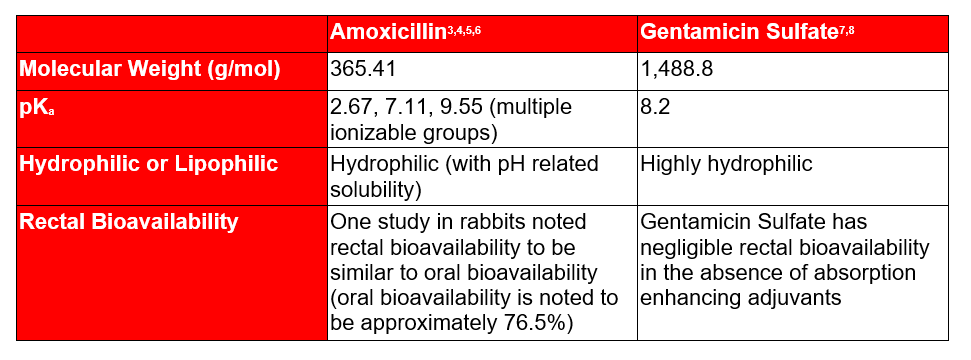.png)
As the weather begins to take a turn for the colder in the northern hemisphere, we tend to see antibiotic prescriptions increase. Data from the US Census Bureau notes a significant increase in antibiotic prescriptions between the months of October and March.1 With this increase in antibiotic prescriptions, we tend to see an increase in requests for compounded antibiotic formulations, including in suppository form for systemic use. Unfortunately, there is currently little data on antibiotic bioavailability through the rectal route. In this newsletter, we will review considerations for rectal delivery of antibiotics, as well as what studies do currently exist suggesting bioavailability through the rectal route for various antibiotics.
Not all active ingredients can be well absorbed rectally or vaginally. Generally, before beginning formulation design, it is best to review existing literature to see if there is data on systemic absorption from rectal routes, and if so, how well a given active ingredient is absorbed. Primary literature regarding bioavailability, recommended vehicle type (hydrophilic or lipophilic) and any necessary excipients is essential to determining whether the rectal route is appropriate for a given antibiotic. If literature is not available, we can review drug characteristics to determine if it is something that may be well absorbed rectally based on parameters that are known to be associated with rectal bioavailability and membrane permeability. The absorption of rectal antibiotics is primarily based on passive transport , therefore, drugs with lipophilic characteristics, relatively low molecular weight, and drugs that are not in an ionized state have a better chance of absorption through the rectal mucosa.2 The rectum has a relatively neutral pH, drugs with a pKa (a value reflective of acid dissociation) near or above physiologic range will be more readily absorbed, as they will not be ionized in the rectal fluid, making them more lipophilic.2
Taking these criteria into consideration, see the below table comparing two antibiotics that have both been studied for rectal use.

Though the profile of amoxicillin does not meet all our criteria for rectal absorption, given its relatively low molecular weight and pKa near neutral, it is not surprising that rectal bioavailability is such that dosing via this route could be possible. One study in rabbits with 100mg or 200mg doses in PEG or fatty acid suppository bases noted significant bioavailability, comparative to that of oral dosing, suggesting the rectal route may be feasible if the oral route is not an option for this antibiotic.5 Similarly, given that gentamicin sulfate doesn’t meet any of our criteria - it is very hydrophilic, it doesn’t have a pKa near neutral (and is therefore likely to be ionized in the rectal fluid), and it has a large molecular weight - it follows that studies have noted absorption to be poor outside of the addition of absorption enhancing adjuvants.
Much like gentamicin sulfate, some antibiotics may meet none of these criteria that make them good candidates for rectal absorption, making dosing via this route difficult. There are some methods that can further assist with the delivery of drugs with poor rectal bioavailability, including the addition of surfactants such as sodium lauryl sulfate or polysorbate. For example, one study of rectal absorption of the antibiotic latamoxef sodium in Witepsol H15, found that the addition of polysorbate 80 significantly increased release rate of the antibiotic and could significantly enhance both release rate of the suppository and membrane permeability of the rectum.9 Another study looking at gentamicin rectal absorption in rabbits administered gentamicin (60mg) with absorption enhancing adjuvants (90mg of either sodium salicylate or sodium caprylate), with these adjuvants, bioavailability of 58-59% was noted, without them, they noted that absorption of gentamicin was not significant.8 Similarly, another study in rabbits found that polysorbate 1% incorporated into metronidazole suppositories improved rectal bioavailability.10
Even if an antibiotic does have the appropriate characteristics making it a good candidate for systemic absorption, the characteristics of the suppository vehicle can still impact rate and extent of drug release, and therefore bioavailability. Though it may seem counter intuitive, more rapid release is typically achieved in a suppository vehicle where the base is not solubilized.11 The general rule is:

One study compared tinidazole release from polyethylene glycol (PEG) type suppositories, and lipophilic type suppositories (Witepsol H-15 and H-35) and found better release from the PEG type bases. Given tinidazole’s poor aqueous solubility, its superior release from a hydrophilic type PEG base is in line with what is expected based on the above chart.12
Antibiotics are sometimes a necessity when dealing with infection, unfortunately, for many key antimicrobial agents, little to no information exists regarding rectal bioavailability. If information does exist to suggest bioavailability, selecting the appropriate suppository vehicle and, if necessary, absorption enhancing adjuvants, can make a big difference in overall bioavailability and drug release. If the oral route or alternative routes, such as intravenous administration, are not options, the rectal route may be considered for some antimicrobial agents. Head to www.fagronacademy.us/facts to check out our table reviewing existing data for various antibiotics via the rectal route.
Sources:
- Suda KJ, Hicks LA, Roberts RM, Hunkler RJ, Taylor TH. Trends and seasonal variation in outpatient antibiotic prescription rates in the United States, 2006 to 2010. Antimicrob Agents Chemother. 2014;58(5):2763-6.
- Hua S. Physiological and pharmaceutical considerations for rectal drug formulations. Front Pharmacol. 2019; 10: 1196
- Kaur S, Rao R, Nanda S. Amoxicillin: A broad spectrum antibiotic. International Journal of Pharmacy and Pharmaceutical Sciences. 2011; 3(3): 30-37.
- Ozdemir Z, Uney B. Distribution of hydrophilic and lipophilic antibacterial drugs in skim milk, cream, and casein. Journal of Dairy Science. 2018: 101(12): 10694-10702.
- Purohit TJ, Hanning SM, Amirapu S, Wu Z. Rectal bioavailability of amoxicillin sodium in rabbits: Effects of suppository base and drug dose. J Control Release. 2021;338:858-869. doi:10.1016/j.jconrel.2021.09.015
- Arancibia A, Guttmann J, González G, González C. Absorption and disposition kinetics of amoxicillin in normal human subjects. Antimicrob Agents Chemother. 1980;17(2):199-202. doi:10.1128/AAC.17.2.199
- Scholar E. Gentamicin. xPharm: The Comprehensive Pharmacology Reference. 2007; 1-6.
- Matsumoto Y, Watanabe Y, Tojima T, Murakoshi R, Murakami C, Matsumoto M. Rectal absorption enhancement of gentamicin in rabbits from hollow type suppositories by sodium salicylate or sodium caprylate. Drug Des Deliv. 1989;4(3):247-256.
- Nakanishi K, Masukawa T, Masada M, Nadai T. Improvement of the rectal bioavailability of latamoxef sodium by adjuvants following administration of a suppository. Biol Pharm Bull. 1994;17(11):1496-1500. doi:10.1248/bpb.17.1496
- Ofoefule, Sabinus I. PhD1; Ibezim, Emmanuel C. PhD1; Esimone, Okechukwu C. B Pharm1; Pepple, Miriam N. PhD1; Njoku, Chinedu N. PhD2; Orisakwe, Ebere O. PhD3,*. Bioavailability of Metronidazole in Rabbits After Administration of a Rectal Suppository. American Journal of Therapeutics: 2004: 11(3): 190-193
- Ham AS, Buckheit RW Jr. Designing and developing suppository formulations for anti-HIV drug delivery. Ther Deliv. 2017;8(9):805-817. doi:10.4155/tde-2017-0056
- Yousif H. Formulation of tinidazole rectal suppositories. 2011: 10(2): DOI: https://doi.org/10.32947/ajps.v10i2.297.



